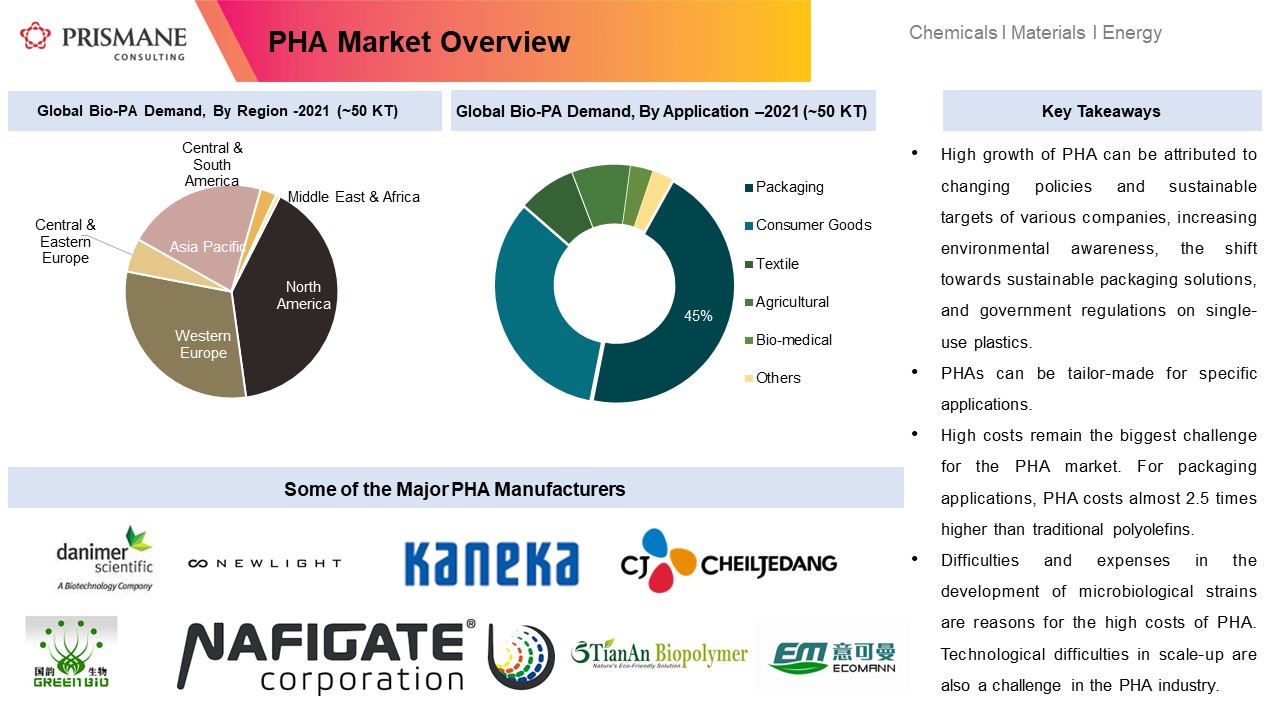PHA (Polyhydroxyalkanoates) Market Overview
The global Polyhydroxyalkanoates capacity was estimated to be around 65 kilotons in 2021. Major PHA players like Danimer Scientific, Newlight Technologies, and RWDC Industries have announced capacity expansions to be operational in the short and mid-term forecast, aiming to reach a global capacity of 560 kilo tons by 2027. Currently, Danimer Scientific is the largest Polyhydroxyalkanoates producer globally, operating facilities in Bainbridge and Winchester. The company is planning to expand both facilities, targeting a capacity of 144 kilo tons by the end of 2024. Newlight Technologies commenced commercial Polyhydroxyalkanoates production in September 2020 with a facility capacity of 23 kilo tons. Other significant producers include RWDC Industries, Ecomann Technologies, CJ CheilJadang, Tainjin GreenBio, and Kaneka.
Leading companies across industries are increasingly shifting their focus to bio-based packaging solutions to meet sustainability targets. The Polyhydroxyalkanoates demand, driven by its biodegradability and sustainability attributes, is at the forefront of this transformation. One key advantage of PHA is its ability to be manufactured from third-generation feedstock, resulting in a carbon-negative footprint. This reinforces its environmental benefits and makes it an attractive choice for various applications.
Collaborations between leading Polyhydroxyalkanoates manufacturers and end-users, especially in the packaging and textiles industry, are fuelling the Polyhydroxyalkanoates consumption. Packaging accounted for about half of the global Polyhydroxyalkanoates demand in 2021, with prominent companies like PepsiCo, Nestle, IKEA, and Bacardi partnering with major Polyhydroxyalkanoates manufacturers such as Danimer and Newlight. These collaborations involve production, commercialization, and the purchase of PHA for packaging applications. As major consumers of plastic packaging, these companies are increasingly seeking sustainable packaging solutions, which serves as a significant driver for the growth of the Polyhydroxyalkanoates market.
PHA Market Dynamics
PHA Market Driver: Biodegradability & Sustainability
PHA is one of the very few bioplastics which degrades even under Ocean. Various companies are shifting their focus towards bio-based packaging solutions to meet their sustainability targets. Biodegradability and sustainability are key drivers of Polyhydroxyalkanoates market. PHAs manufactured from 3rd generation feedstock have carbon negative footprint. Growing environmental concerns and a move towards sustainable practices is driving the demand for eco-friendly materials like PHA. PHAs are biodegradable and renewable polymer derived from renewable resources. Its ability to replace petroleum-based plastics makes it an attractive material for various end-use industries, including packaging, agriculture, medical, and consumer goods.
PHA Market Challenge: High Cost
High cost is still the biggest challenge for the Polyhydroxyalkanoates market. For Packaging applications PHA cost is almost 2.5 times higher than traditional polyolefins. Difficulties and expenses in development of microbiological strain is a reason for high PHA cost. Technological difficulties in scale-up is also another challenge in the Polyhydroxyalkanoates market. PHA is expected to be more cost-competitive with traditional polymers as various technological developments in production process are expected to reduce the manufacturing cost. Also, increasing crude oil prices and regulations on traditional plastics will also benefit the Polyhydroxyalkanoates market.
Recent Developments in Polyhydroxyalkanoates
Recent Developments in Polyhydroxyalkanoates
Newlight Technologies has entered into agreements with a range of companies in the textile, packaging, and consumer goods sectors. Among them, Nike has signed an off-take agreement with Newlight, committing to purchase PHA for their apparel business.
Additionally, furniture and packaging giant IKEA signed an agreement with Newlight in 2016, with IKEA planning to procure 50% of the Polyhydroxyalkanoates produced by Newlight's 23 kilo ton plant in California. This move aligns with IKEA s goal of becoming a carbon-negative company by 2030, driving their adoption of sustainable solutions like PHA.
Newlight has also formed agreements with other consumer goods companies such as The Body Shop, as well as major electronics manufacturers like Dell and Hewlett-Packard (HP).
CJ Biomaterials, a leading Bioplastics manufacturer has teamed up with Dongil Platech (a manufacturer of drinking straws in South Korea) to develop straws made from blend of polylactic acid and amorphous polyhydroxyalkanoate.
Kaneka, the sole Polyhydroxyalkanoates producer in Japan, has made a significant investment of JPY 15 billion (approximately EUR 126 million) to enhance PHA production at its Taksago facility. The expansion project aims to increase production capacity by 5 kilo tons, with completion anticipated by early 2024. This expansion will raise Kaneka's total PHA capacity to 20 kilotons per year.
In July 2022, Angel Yeast and Beijing PhaBuilder Biotechnology joint venture announced to build a polyhydroxyalkanoates (PHA) polyesters in the Yichang, China. The company will invest around $18 million to build the manufacturing facility with installed capacity of 50 kilo tons. The plant is expected to commence operation by end of 2023.
In 2022, Hyundai Oilbank, a subsidiary of Hyundai shipbuilding group in South Korea, has entered into a partnership with Danimer Scientific, a US-based biopolymer manufacturer, to collaborate on the development of degradable plastic products utilizing Polyhydroxyalkanoates. The two companies, will collaborate on PHA research, marketing, and manufacturing, also focusing on the creation of valuable applications using PHA. Additionally, they will explore the possibility of joint investments in production facilities of PHA to cater to the increasing demand in the Asian market.

